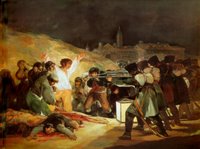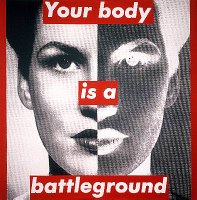This past week I gave my first exam on the first six chapters of the textbook and class lectures. It was an in class short answer test based on four slides. The first question was on a work by Kandinsky in which they were to describe the work in terms of elements and principles and then briefly discuss whether they thought the work to be successful or not. They were asked to do the same with Goya's Third of May. For the last question they were asked to compare Da Vinci's Mona Lisa with Barbara Kruger's Your Body is a Battle Ground



These images were similar to images the students saw in class and had already talked about. A week before students gave peer reviews of art work with a very similar question of elements and principles. They had also in small discussion compared works through critique. The students were very nervous before test but during I saw smiles and positive body language (shoulders up, not slouching on the table, confident strides to turn in their papers and mixed comments afterwards about it not being that hard)
Why did it happen? Responses to the test format were mixed. For the most part students seemed to doubt their writing abilities or handwriting abilities. Some wanted something more concrete or a specific outline to study with. I attempted to show in class activities, conversation, and lecture that if I wanted the right answer I could formulate it myself. Instead I wanted a thoughtful answer. They were unsure of this as it was outside their experience. Because it was their thoughts there was no safety net, they had to think! I did however through some scaffolding attempt to model the response with activities which gave them experience in these types of questions and gave them images they had seen before or something close to what they had seen before. I think the positive responses were due to a safe experience where thinking was encouraged but not thrown upon them.
What does it mean? In the preparation of a class like this the teacher, in this case myself) has to truly think ahead to prepare students to think critically, It must be modeled and they must have space to try it out! It is also true that taking away the quest for the right answer is scary for some. Asking them to think is a much harder request and it needs to be supported with resources and time so they feel ready to do this in a test format.
More theoretically, I think it this example helps me to suggest that college and course standards can be met without enforcing right answers and standard responses. These kinds of classes can be impactful for the students in allowing them to take take the lead in learning without throwing them to the wolves with criticality and power issues. This is a process and like I mentioned in may last entry, we are working to get more critical but it does not happen over night. This exam was a huge step and the students really rose to the challenge with great thoughts mixed with correct vocabulary and criticism.
Implications for practice: I will probably never give a multiple choice test again or assume that an essay it the only way to go. Students responded well to short answer in the classroom. They needed guidance to answer the questions but most went beyond the specific question. I once thought if I modeled too much I would be forcing students in a certain direction of planting ideas instead of fostering them. Modeling is a great tool for getting critical thought. It doesn't mean planting ideas but instead inspiring them and allowing for some comfort when trying out new skills.
I also have to continue to look critically at the images I show. I am in the process of teaching with images given to me and then adding some of my own. As I have time after teaching to sit and reflect I will need to question my image choices. These works worked with this group but they may not work with all students. They are kind of heavy hitters in the world of art history and that needs to be looked at carefully as I carry on. But that is another blog for another day.
Wednesday, March 08, 2006
Testing
Posted by
Sarah
at
2:00 PM
![]()
Subscribe to:
Post Comments (Atom)
No comments:
Post a Comment